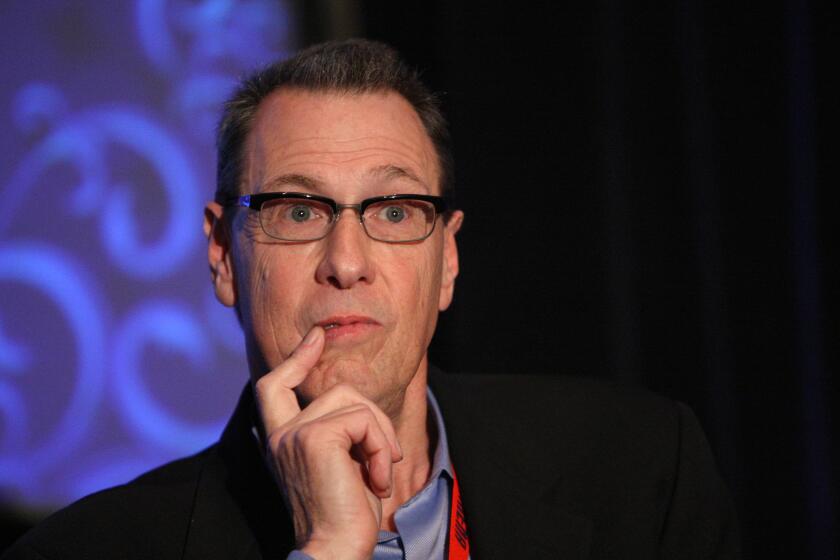Kurt Meyer dies at 92; L.A. architect was committed to civic service
Architect Kurt Meyer not only designed numerous commercial buildings in Los Angeles noted for their Mid-Century style, he was also a champion of saving the city’s architectural treasures. But at first, the Swiss-born Meyer wanted nothing to do with L.A.
He arrived in 1949 with his first wife, Rosemary. “He went out early one morning to drive around and came back and said, ‘Pack up, let’s go to San Francisco,’” said Pamela Meyer, his third wife.
But Rosemary informed him that they didn’t have enough money to pay their motel bill. So he got a job as a draftsman and they stayed. Eventually he became one of the city’s most successful architects, specializing in commercial buildings.
------------
FOR THE RECORD:
Kurt Meyer: A news obituary of architect Kurt Meyer in the Aug. 29 LATExtra section named Catherine Bach as the founding president of the Los Angeles Conservancy. Her name is Margaret Bach.
------------
Meyer, 92, died Aug. 18 at his home in Los Angeles, after an eight-year battle with Parkinson’s disease, said Pamela Meyer.
Even after retiring to spend most of his time in Nepal, where he and Pamela Meyer studied and photographed a remote group of indigenous people for several years, Meyer kept Los Angeles as his home base.
His buildings were not flashy for the most part, though they had stylish touches. One of the most prominent is a 1960 bank at the corner of Sunset and Crescent Heights boulevards that sports zigzag, accordion-like folds in its roof.
“It’s very dramatic,” said Linda Dishman, executive director of the Los Angeles Conservancy. “It was designed for the auto culture to see it from the street.”
Architectural historian Alan Hess, who has written several books on Mid-Century Modern design, said Meyer didn’t have a signature style, “which is one reason he is not as well-known as some other architects of the period. But whatever style he was working in, he brought a real sense of quality to his buildings.”
A notable example is another bank building, at South Beverly Drive and Pico Boulevard, with massive concrete columns, a hallmark of the New Brutalism style. “This is a really good example of it,” Hess said. “The columns and cross-members are designed so you have interesting light and shadows playing across the texture of the concrete.”
Kurt Werner Meyer was born June 3, 1922, in Zurich. He studied architecture at the Swiss Federal Institute of Technology and served in the Swiss Army during World War II. In 1948, he came to the U.S., first living in Harrisburg, Pa., before making the cross-country trip that resulted in his settling in L.A.
He opened his own practice in 1957, gaining a reputation for designing financial institutions, including those of flamboyant screenwriter-turned-banker Bart Lytton.
Among the firm’s biggest projects were the Exxon regional headquarters complex in Thousand Oaks that opened in 1983 and the South Coast Air Quality Management District building in Diamond Bar dedicated in 1991. His firm also drew up master plans for Simi Valley’s civic center, the city of San Fernando’s business center and several other cities and institutions.
In the 1960s, Meyer got involved in the effort to save the legendary Dodge House in West Hollywood designed by Irving Gill. The 1916 home, considered the pinnacle of Gill’s work, was bought by Lytton in 1967. Meyer drew up a plan to preserve the house as part of a development.
But Lytton’s financial empire came apart and the house fell into the hands of developers who demolished it in a single day in 1970. When the Los Angeles Conservancy was created eight years later, Meyer took part in its inaugural news conference and was on its first advisory council. “Kurt was a passionate advocate for great architecture in Los Angeles,” said the conservancy’s founding president, Catherine Bach. “The ghost of the Dodge House hovered over our efforts.”
Meyer got involved with several other civic organizations and was appointed by Mayor Tom Bradley to the Community Redevelopment Agency charged with spurring development in underserved areas. Meyer was CRA chairman from 1976 to 1978, during which time the agency participated in several low-income housing projects.
His own practice was cut back during his time with the CRA, but he told The Times in 1983 that he and some other architects emphasized the importance of civic service. “I don’t believe that it comes down to a choice of serving the community or running a successful practice,” he said. “We have all demonstrated that it is possible to do both.”
He sold his firm in 1992 to pursue a lifelong interest in the Himalayas.
In addition to his wife, Meyer is survived by daughter Susanne Christopher of Portland, Ore.; sons Randy Meyer of Los Angeles and Rick Meyer of Simi Valley; three grandchildren and two great-grandchildren. His first two marriages ended in divorce.
Twitter: @davidcolker
More to Read
Start your day right
Sign up for Essential California for the L.A. Times biggest news, features and recommendations in your inbox six days a week.
You may occasionally receive promotional content from the Los Angeles Times.







